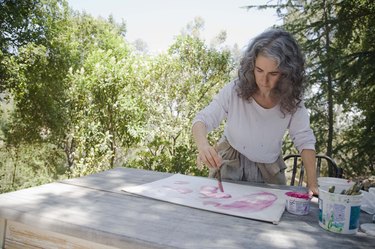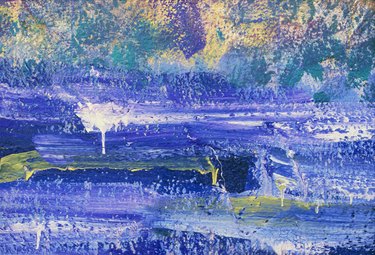Things You'll Need
Paint
Water or solvent thinner
Brush or stick
Painting medium

When making dripping paint artwork, gravity acts upon the cohesive liquidity of the paint. To paint dripping effects that are somewhat predictable, practice different dripping methods using paint thinned to various degrees. Gravity is used in this process by holding the canvas at any angle and the process is stopped by laying the canvas flat on a level plane. The volume of paint applied and surface tension are important factors. Some of the best dripping paint effects are by nature a "happy accident."
Step 1

Practice the dripping paint effect on some cardboard. Thin the paint to smoothie consistency or thinner. Place the cardboard vertically; paint a very wet horizontal line across the cardboard. Watch what happens. When the line has dripped enough lay the painting flat and level to dry.
Video of the Day
Step 2

Practice working with the volume of paint applied. There needs to be enough paint applied to begin the dripping process but not so much paint that it pools outward when the painting is placed horizontally to dry. Some rapidly drying paints, like lacquer, will drip and dry quickly making pooling less of a factor. A technique that works well at controlling the dripping process is to lay the canvas flat, paint on a volume of paint, and with a brush or stick make a short stroke breaking the surface tension in the pool of paint where the drip will be. Slope the canvas upward watching the drip flow down, then lay the canvas flat again to stop the process. Blowing the paint as it drips is another technique you can use.
Step 3
Practice dripping different kinds of paint. Each kind of paint will drip a bit differently. Boat paint and enamels drip quite beautifully, but are toxic and messy. Watercolor drips nicely, but the drips are short. Acrylic paint will drip well when thinned and mixed with mediums. House paint works well for a budget wise material that is relatively easy to control.
Step 4
Make the painting. There is no way to completely control the process. Overly manipulated drip painting will look manipulated. Spontaneity is the process. Getting a handle on spontaneity is the purpose of the practice work. Draw on the experience gained during the practice tests. Work with the spontaneous nature of the process. Pick the moment and do it, watch it happen then lay the painting flat and level to dry.
Video of the Day